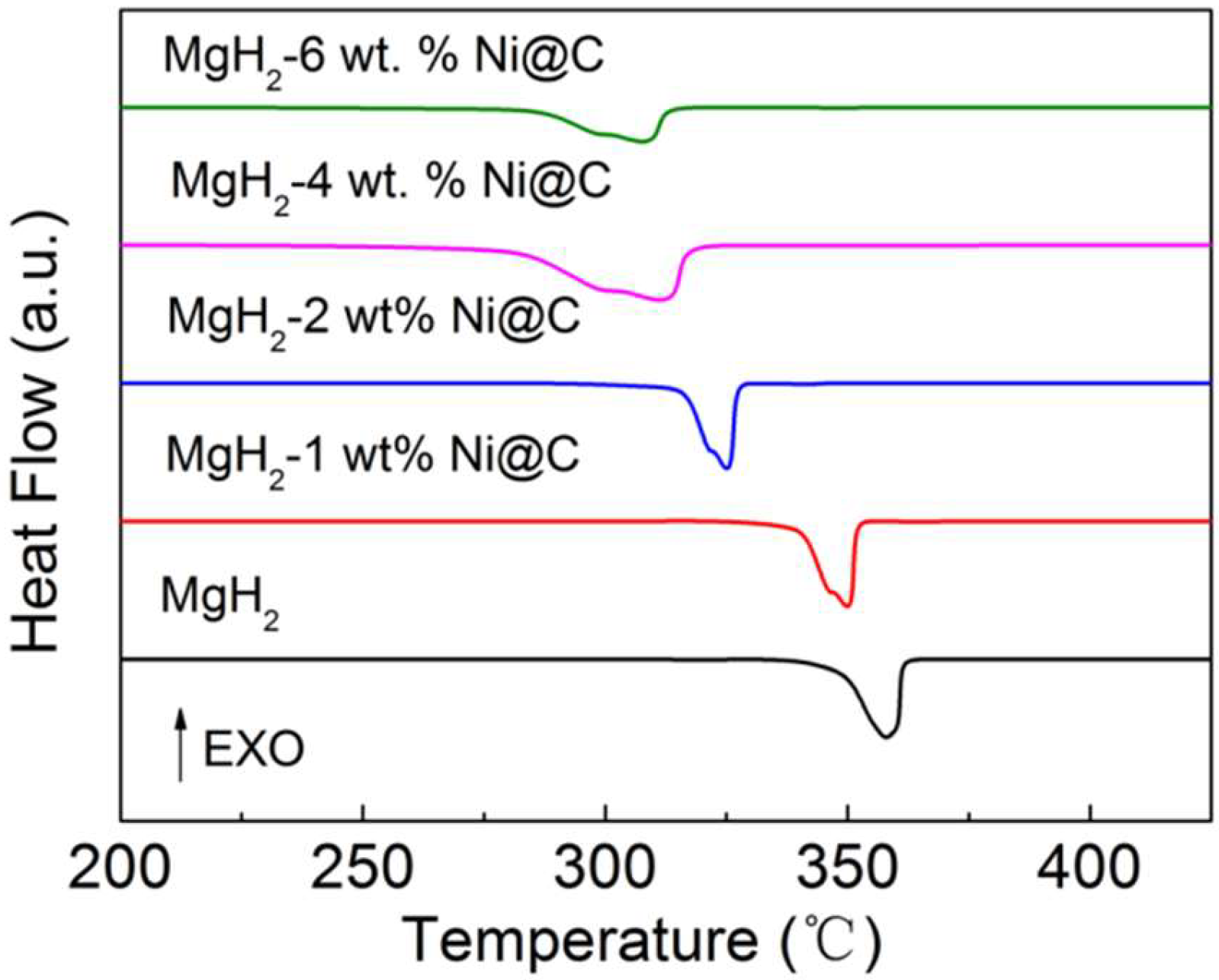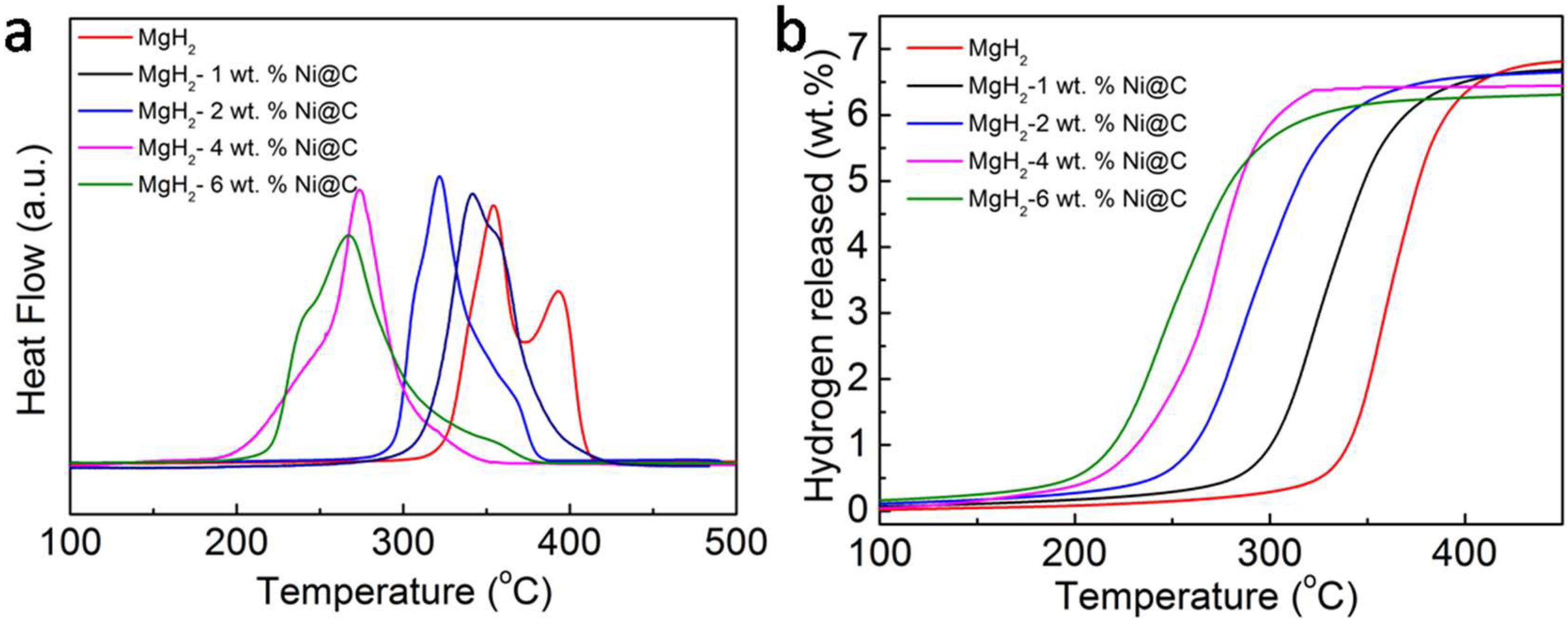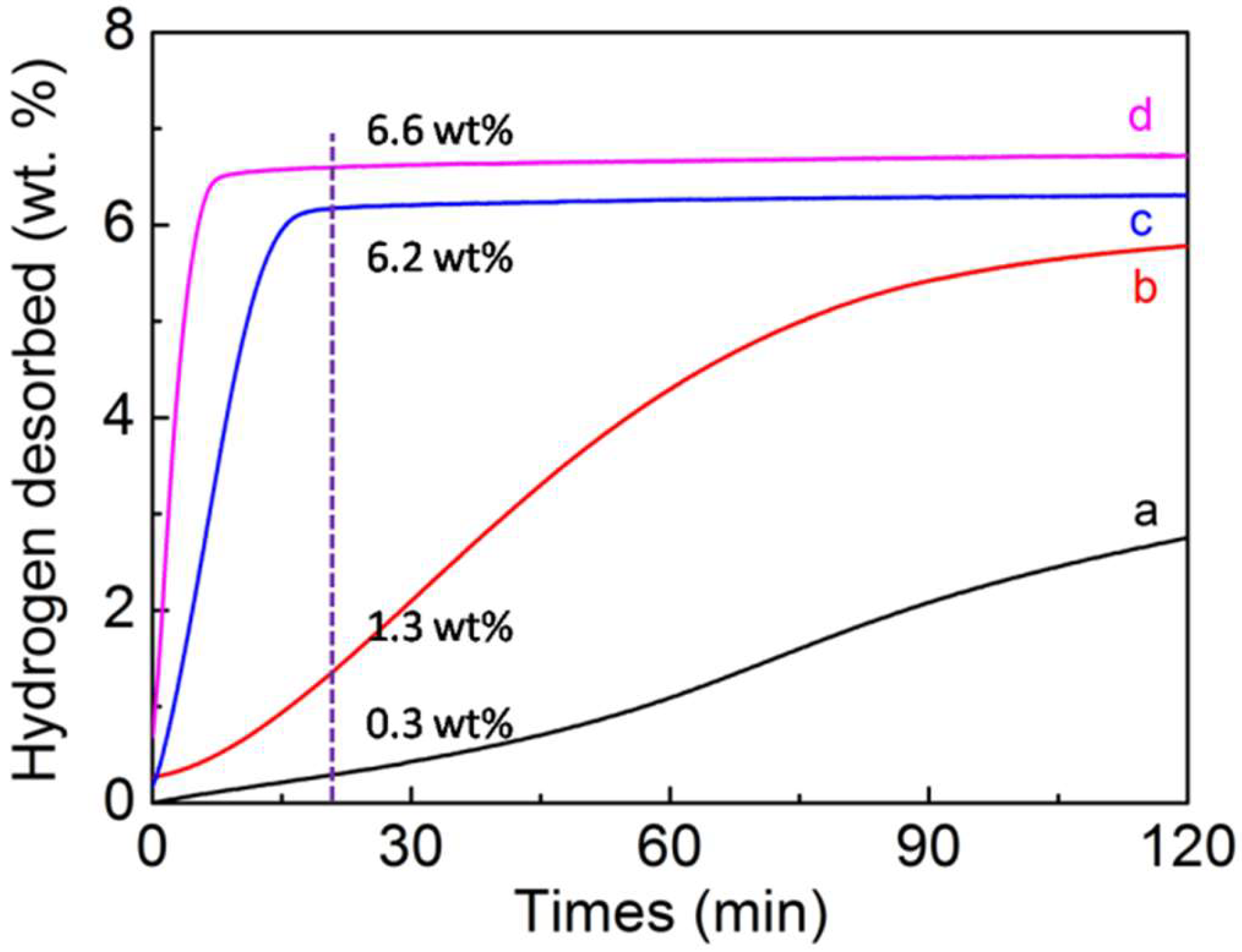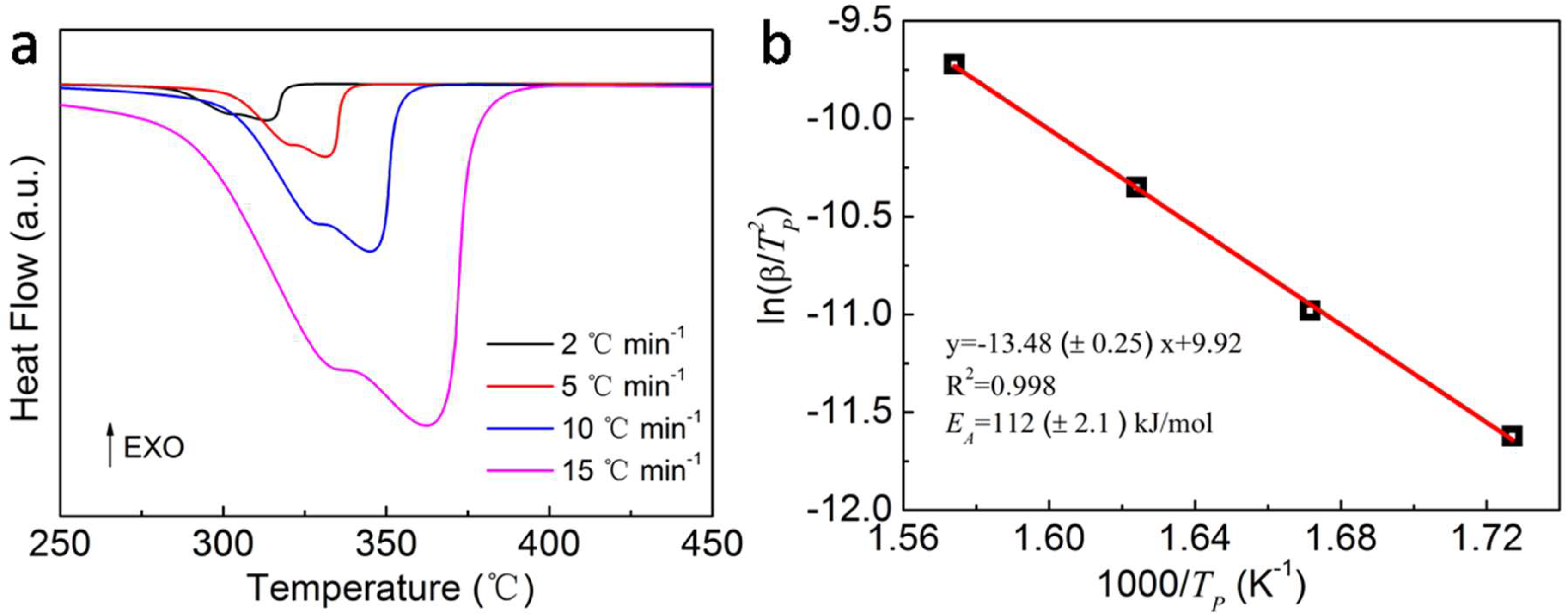Improvement of Hydrogen Desorption Characteristics of MgH2 With Core-shell Ni@C Composites
Abstract
1. Introduction
2. Results and Discussion
3. Materials and Methods
4. Conclusions
Author Contributions
Acknowledgments
Conflicts of Interest
References
- Tollefson, J. Fuel of the future. Nature 2010, 464, 1262–1264. [Google Scholar] [CrossRef] [PubMed]
- He, T.; Pachfule, P.; Wu, H.; Xu, Q.; Chen, P. Hydrogen carrier. Nat. Rev. Mater. 2017, 2, 16059. [Google Scholar] [CrossRef]
- Schlapbach, L.; Zuttel, A. Hydrogen-storage materials for mobile applications. Nature 2001, 414, 353–358. [Google Scholar] [CrossRef] [PubMed]
- Highfield, J. Advances and recent trends in heterogeneous photo(electro)-catalysis for solar fuels and chemicals. Molecules 2015, 20, 6739–6793. [Google Scholar] [CrossRef] [PubMed]
- Yang, J.; Sudik, A.; Wolverton, C. High capacity hydrogen storage materials: Attributes for automotive applications and techniques for materials discovery. Chem. Soc. Rev. 2010, 39, 656–675. [Google Scholar] [CrossRef] [PubMed]
- Wang, M.; Chen, L.; Sun, L. Recent progress in electrochemical hydrogen production with earth-abundant metal complexes as catalysts. Energy Environ. Sci. 2012, 5, 6763–6778. [Google Scholar] [CrossRef]
- Nielsen, T.K.; Manickam, K.; Hirscher, M. Confinement of MgH2 nanoclusters within nanoporous aerogel scaffold materials. ACS Nano 2009, 3, 3521–3528. [Google Scholar] [CrossRef] [PubMed]
- Aguey-Zinsou, K.F.; Ares-Fernandez, J.R. Hydrogen in magnesium: New perspectives toward functional stores. Energy Environ. Sci. 2010, 3, 526–543. [Google Scholar] [CrossRef]
- Stampfer, J.F.; Holley, C.E.; Suttle, J.F. The Magnesium Hydrogen system. J. Am. Chem. Soc. 1960, 82, 3504–3508. [Google Scholar] [CrossRef]
- Bardhan, R.; Ruminski, A.M.; Brand, A. Magnesium nanocrystal-polymer composites: A new platform for designer hydrogen storage materials. Energy Environ. Sci. 2011, 4, 4882–4895. [Google Scholar] [CrossRef]
- Wang, Y.; Li, L.; An, C.H.; Wang, Y.J.; Chen, C.C.; Jiao, L.F.; Yuan, H.T. Facile synthesis of TiN decorated graphene and its enhanced catalytic effects on dehydrogenation performance of magnesium hydride. Nanoscale 2014, 6, 6684–6691. [Google Scholar] [CrossRef] [PubMed]
- Mukherjee, D.; Okuda, J. Molecular magnesium hydrides. Angew. Chem. Int. Edit. 2018, 57, 1458–1473. [Google Scholar] [CrossRef] [PubMed]
- Jeon, K.J.; Moon, H.R.; Ruminski, A.M.; Jiang, B.; Kisielowski, C.; Bardhan, R. Air-stable magnesium nanocomposites provide rapid and high-capacity hydrogen storage without using heavy-metal catalysts. Nat. Mater. 2011, 10, 286–290. [Google Scholar] [CrossRef] [PubMed]
- Hanada, N.; Ichikawa, T.; Fujii, H. Catalytic effect of nanoparticle 3d-transition metals on hydrogen storage properties in magnesium hydride MgH2 prepared by mechanical milling. J. Phys. Chem. B 2005, 109, 7188–7194. [Google Scholar] [CrossRef] [PubMed]
- Pozzo, M.; Alfè, D. Hydrogen dissociation and diffusion on transition metal (=Ti, Zr, V, Fe, Ru, Co, Rh, Ni, Pd, Cu, Ag)-doped Mg (0001) surfaces. Int. J. Hydrogen Energy 2009, 34, 1922–1930. [Google Scholar] [CrossRef]
- Jangir, M.; Jain, A.; Agarwal, S.; Zhang, T.; Kumar, S.; Selvaraj, S.; Ichikawa, T.; Jain, I. The enhanced de/re-hydrogenation performance of MgH2 with TiH2 additive. Int. J. Energy Res. 2018, 42, 1139–1147. [Google Scholar] [CrossRef]
- Bogdanović, B. Catalytic synthesis of organolithium and organomagnesium compounds and of lithium and magnesium hydrides—applications inorganic synthesis and hydrogen storage. Angew. Chem. Int. Ed. 1985, 24, 262–273. [Google Scholar] [CrossRef]
- Wang, Z.; Ren, Z.; Jian, N.; Gao, M.; Hu, J.; Du, F.; Pan, H.; Liu, Y. Vanadium oxide nanoparticles supported on cubic carbon nanoboxes as highly active catalyst precursors for hydrogen storage in MgH2. J. Mater. Chem. A 2018, 6, 16177–16185. [Google Scholar] [CrossRef]
- Kumar, S.; Jain, A.; Miyaoka, H.; Ichikawa, T.; Kojima, Y. Catalytic effect of bis(cyclopentadienyl) nickel (II) on the improvement of the hydrogenation dehydrogenation of Mg-MgH2 system. Int. J. Hydrogen Energy 2017, 42, 17178–17183. [Google Scholar] [CrossRef]
- Terzieva, M.; Khrussanova, M.; Peshev, P. Dehydriding kinetics of mechanically alloyed mixtures of magnesium with some 3d transition metal oxides. Int. J. Hydrogen Energy 1991, 16, 265–270. [Google Scholar] [CrossRef]
- Hanada, N.; Ichikawa, T.; Fujii, H. Catalytic effect of Ni nano-particle and Nb oxide on H-desorption properties in MgH2 prepared by ball milling. J. Alloy. Compd. 2005, 404, 716–719. [Google Scholar] [CrossRef]
- Xie, X.; Chen, M.; Liu, P.; Shang, J.; Liu, T. Highly hydrogen desorption properties of Mg-based nanocomposite at moderate temperatures: The effects of multiple catalysts in situ formed by adding nickel sulfides/graphene. J. Power Sources 2017, 371, 112–118. [Google Scholar] [CrossRef]
- Liang, G.; Huot, J.; Boily, S.; Neste, A.; Schulz, R. Catalytic effect of transition metals on hydrogen sorption in nanocrystalline ball milled MgH2-Tm (Tm = Ti, V, Mn, Fe and Ni) systems. J. Alloys Compd. 1999, 292, 247–252. [Google Scholar] [CrossRef]
- Milošević, S.; Kurko, S.; Pasquini, L.; Matović, L.; Vujasin, R.; Novaković, N.; Novaković, J. Fast hydrogen sorption from MgH2-VO2(B) composite materials. J. Power Sources 2016, 307, 481–488. [Google Scholar] [CrossRef]
- Xia, G.; Tan, Y.; Chen, X.; Sun, D.; Guo, Z.; Liu, H.; Ouyang, L.; Zhu, M.; Yu, X. Monodisperse magnesium hydride nanoparticles uniformly self-assembled on graphene. Adv. Mater. 2015, 27, 5981–5988. [Google Scholar] [CrossRef] [PubMed]
- Barkhordarian, G.; Klassen, T.; Bormann, R. Catalytic mechanism of transition-metal compounds on Mg hydrogen sorption reaction. J. Phys. Chem. 2006, 110, 11020–11024. [Google Scholar] [CrossRef] [PubMed]
- Zhang, J.; Shi, R.; Zhu, Y.; Liu, Y.; Zhang, Y.; Li, S.; Li, L. Remarkable synergistic catalysis of Ni-doped ultrafine TiO2 on hydrogen sorption kinetics of MgH2. ACS Appl. Mater. Interfaces 2018, 10, 24975–24980. [Google Scholar] [CrossRef] [PubMed]
- Zhang, J.; Li, S.; Zhu, Y.; Lin, H.; Liu, Y.; Zhang, Y.; Ma, Z.; Li, L. Controllable fabrication of Ni-based catalysts and their enhancement on desorption properties of MgH2. J. Alloys Compd. 2017, 715, 329–336. [Google Scholar] [CrossRef]
- An, C.; Liu, G.; Li, L.; Wang, Y.; Chen, C.; Wang, Y.; Jiao, L.; Yuan, H. In situ synthesized one-dimensional porous Ni@C nanorods as catalysts for hydrogen storage properties of MgH2. Nanoscale 2014, 6, 3223–3230. [Google Scholar] [CrossRef] [PubMed]
- Huang, X.; Xiao, X.; Zhang, W.; Fan, X.; Zhang, L.; Cheng, C.; Li, S.; Ge, H.; Wang, Q.; Chen, L. Transition metal (Co, Ni) nanoparticles wrapped with carbon and their superior catalytic activities for the reversible hydrogen storage of magnesium hydride. Phys. Chem. Chem. Phys. 2017, 19, 4019–4029. [Google Scholar] [CrossRef] [PubMed]
- Chen, G.; Zhang, Y.; Chen, J.; Guo, X.; Zhu, Y.; Li, L. Enhancing hydrogen storage performances of MgH2 by Ni nano-particles over mesoporous carbon CMK-3. Nanotechnology 2018, 29, 265705. [Google Scholar] [CrossRef] [PubMed]
- Lillo-Ródenas, M.; Aguey-Zinsou, K.; Cazorla-Amoros, D.; Linares-Solano, A.; Guo, Z. Effects of carbon-supported nickel catalysts on MgH2 decomposition. J. Phys. Chem. C 2008, 112, 5984–5992. [Google Scholar] [CrossRef]
- Jia, Y.; Yao, X. Carbon scaffold modified by metal (Ni) or non-metal (N) to enhance hydrogen storage of MgH2 through nanoconfinement. Int. J. Hydrogen Energy 2017, 42, 22933–22941. [Google Scholar] [CrossRef]
- Kissinger, H. Reaction kinetics in differential thermal analysis. Anal. Chem. 1957, 29, 1702–1706. [Google Scholar] [CrossRef]
- Zhang, Q.; Xu, Y.; Wang, Y.; Zhang, H.; Wang, Y.; Jiao, L.; Yuan, H. Enhanced hydrogen storage performance of MgH2-NiP/graphene nanosheets. Int. J. Hydrogen Energy 2016, 41, 17000–17007. [Google Scholar] [CrossRef]
- Zhang, Q.; Zang, L.; Huang, Y.; Gao, P.; Jiao, L.; Yuan, H.; Wang, Y. Improved hydrogen storage properties of MgH2 with Ni-based compounds. Int. J. Hydrogen Energy 2017, 42, 24247–24255. [Google Scholar] [CrossRef]
- Liu, G.; Wang, Y.; Qiu, F.; Li, L.; Jiao, L.; Yuan, H. Synthesis of porous Ni@rGO nanocomposite and its synergetic effect on hydrogen sorption properties of MgH2. J. Mater. Chem. A 2012, 22, 22542–22549. [Google Scholar] [CrossRef]
- An, C.; Wang, Y.; Jiao, L.; Yuan, H. Mesoprous Ni@C hybrids for a high energy aqueous asymmetric supercapacitor device. J. Mater. Chem. A 2016, 4, 9670–9676. [Google Scholar] [CrossRef]
Sample Availability: Samples of the compounds are not available from the authors. |





| Sample | Tonset (°C) | Tpeak (°C) |
|---|---|---|
| pure MgH2 | 343 | 358 |
| MgH2-1 wt.% Ni@C | 336 | 349 |
| MgH2-2 wt.% Ni@C | 314 | 325 |
| MgH2-4 wt.% Ni@C | 289 | 311 |
| MgH2-6 wt.% Ni@C | 286 | 307 |
| Heating Rate (°C min−1) | Dehydrogenation Peak (°C) |
|---|---|
| 2 | 315 |
| 5 | 331 |
| 10 | 345 |
| 15 | 361 |
© 2018 by the authors. Licensee MDPI, Basel, Switzerland. This article is an open access article distributed under the terms and conditions of the Creative Commons Attribution (CC BY) license (http://creativecommons.org/licenses/by/4.0/).
Share and Cite
An, C.; Deng, Q. Improvement of Hydrogen Desorption Characteristics of MgH2 With Core-shell Ni@C Composites. Molecules 2018, 23, 3113. https://doi.org/10.3390/molecules23123113
An C, Deng Q. Improvement of Hydrogen Desorption Characteristics of MgH2 With Core-shell Ni@C Composites. Molecules. 2018; 23(12):3113. https://doi.org/10.3390/molecules23123113
Chicago/Turabian StyleAn, Cuihua, and Qibo Deng. 2018. "Improvement of Hydrogen Desorption Characteristics of MgH2 With Core-shell Ni@C Composites" Molecules 23, no. 12: 3113. https://doi.org/10.3390/molecules23123113
APA StyleAn, C., & Deng, Q. (2018). Improvement of Hydrogen Desorption Characteristics of MgH2 With Core-shell Ni@C Composites. Molecules, 23(12), 3113. https://doi.org/10.3390/molecules23123113






